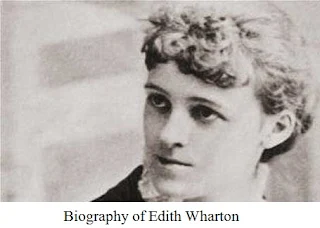Biography of Edith Wharton
 |
| Biography of Edith Wharton |
• Name: Edith Newbold Jones.
• Born: 24 January 1862, New York.
• Father: George Frederick Jones.
• Mother: Lucretia Stevens Rhinelander.
• Wife / Husband: Edward Wharton.
Early life of Edith Wharton:
Edith Wharton was born to Edith Newbold Jones on January 24, 1862, with George Frederick Jones and Lucretia Stevens Rhinelander at their brownstone at 14 West Twenty-Three Street in New York City. He was known as "Pussie Jones" to his friends and family. She had two older brothers, Frederick Rhinelander, who was sixteen, and Henry Edward, who was twelve. He was baptized in Grace Church on Easter Sunday, April 20, 1862.
Wharton's paternal family, the Jones, were a very wealthy and socially distinguished family who made their money in real estate. Is said to refer to his father's family "while living with Jones". He also belonged to Rensseyers, the most distinguished of the old patron families, who received land grants from the former Dutch government of New York and New Jersey.
Her father's first cousin was Caroline Sharmerone Astor. She had a lifelong friendship with her niece, Beatrix Farrand of Reef Point, landscape architect in Bar Harbor, Maine. Fort Stevens in New York was named for Wharton's maternal grandfather, Ebenezer Stevens, a Revolutionary War hero and general.
Although she had taken a personal book of her poems when she was 16, it did not happen until several years after their marriage when Wharton began writing in earnest. His principal literary model was Henry James, whom he knew and his work reveals James's concern for artistic form and moral issues.
He contributed some poems and stories to Harper, Scripper, and other magazines in the 1890s and in 1897, after overseeing the remodeling of a house in Newport, Rhode Island, he collaborated with architect Ogden Codman, Jr. on decorations . Of houses. His next books, The Greater Inclineation (1899) and Crucial Instance (1901), were collections of stories.
Wharton's first novel, The Valley of Decision, was published in 1902. The House of Mirth (1905) was a courtesy novel that analyzed the stratified society in which it was brought up and its response to social change. The book criticized him and garnered audience acclaim. Over the next two decades - the quality of her work began to decline under the demands of writing for women's magazines - she wrote The Reef (1912), The Custom of the Country (1913), Summer (1917), and the like. Wrote novels The Age of Innocence (1920), which won the Pulitzer Prize.
In 1905, after Wharton began his friendship with writer Henry James (1843–1916), his first work, The House of Mirth, uncovered the brutalities of New York City society. His range was clear in Tales of Men and Ghosts (1910), a collection of chillers and the famous novel Ethan Frau (1911).
In 1910 Wharton moved to France, where Edward Wharton suffered a nervous breakdown and was placed in a mentally unstable hospital. After their divorce in 1913, Edith Wharton, living in France, writes fondly about it in French Ways and Their Meanings (1919) and other books.
In 1885, when she was twenty-three, she married Edward ("Teddy") Wharton. Although from a similar social background, he lacked artistic and intellectual interests and after nearly 30 years of marriage, they divorced him. Wharton eventually settled permanently in France, rarely visiting the United States thereafter. In 1908 he began to complete a brief appearance in Paris but eventually formed a hopeless relationship with Morton Fullerton, a London Times journalist and friend of Henry James.
In Paris she found intellectual companionship in circles where rich and well-born artists and writers worked and where women played a leading role. Edith Wharton, one of the leading American novelists and short storytellers of the 20th century, died in 1937 in France. - Abby Warelock, President, Edith Wharton Society.